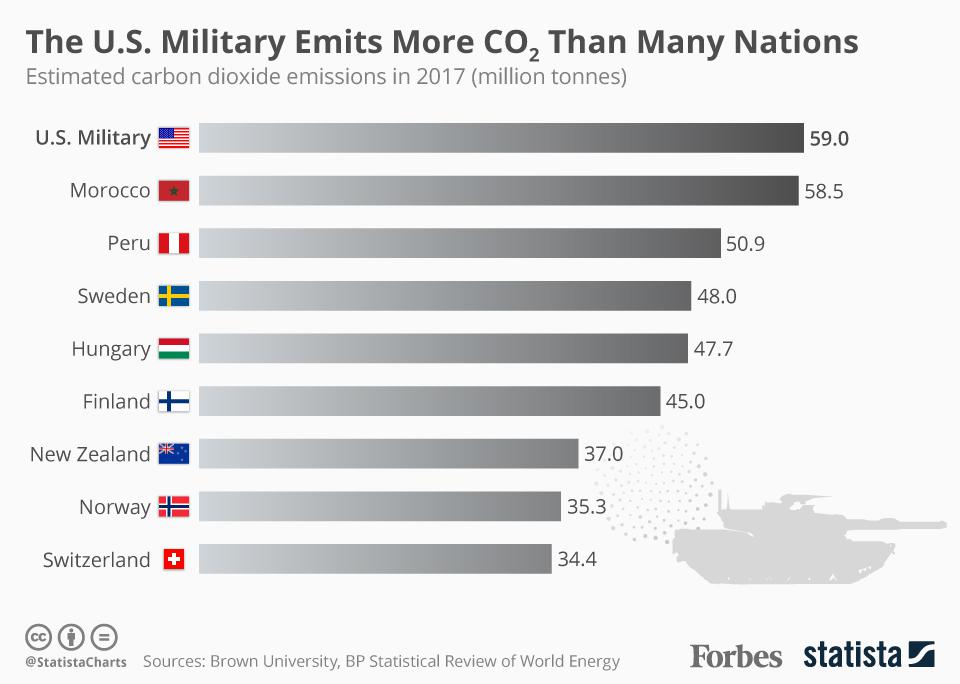
The US Military’s Impact on the Climate Crisis
Is Rarely Mentioned. Here’s What You Should Know
Gary Butterfield / Veterans For Peace San Diego
(April 2024) — Earth Day is rapidly approaching. And, just like last year, people are again focusing efforts to help save our planet. We hear of many ways to change our habits, to include using less plastic and fewer paper towels, changing to better light bulbs, switching to electric cars, and even lessening our reliance on animal proteins and going vegan. Many of our local governments are devising “Climate Plans” so local citizens can have a roadmap of what our cities are doing on a macro level.
However, NONE of these plans address the world’s single largest institutional user of fossils fuels and the single largest emitter of greenhouse gases (GHG). That gross emitter is the US military. And San Diego has the country’s highest number of active duty troops of any county. How is the military’s gross contribution to the climate crisis being factored into the local climate plans?
Did you know that the Pentagon is the world’s single largest institutional user of fossil fuels and the single largest institutional emitter of greenhouse gases (GHG)? In fact, if the Department of Defense were a country, it would rank 47th (out of 170) on the world’s ranking of carbon dioxide-polluting countries, between Peru and Portugal. The US Air Force holds the dubious distinction of being the world’s largest user of jet fuel. ‘
For example, each Thunderbird (or Blue Angels) team that flies overhead (for our entertainment) uses approximately 18,200 gallons of jet fuel per hour. So, if the “show” lasts 40 minutes, that’s about 82,500 pounds of jet fuel, which releases 118 metric tons of carbon dioxide plus the smaller particulates that are emblematic of the combustion of fossil fuel.
So think about these numbers when we are “entertained” by that patriotic flyover at the next sporting event. Consider that when the Navy decides to share their “love of aviation” with us this September.
The Pentagon also maintains over 800 bases in foreign countries, creating extensive and wasteful supply lines. Each of the Army’s 60,000 Humvees gets between 4 to 8 miles per gallon of diesel fuel; the M1 Abrams tank gets about 0.6 mpg.
Add in toxic spills, Agent Orange, burn pits, depleted uranium and unexploded ordnance and you have the profile of a very large, very irresponsible public organization. One that, indeed, is contributing significantly to climate degradation while creating climate refugees in its wake. And more and more attention is now being paid to per- and polyfluoroalkyl substances (PFAS), known as forever chemicals, which don’t break down in the environment and are tied to cancer and other health ailments. PFAS are used widely in industrial and household products, but, very specifically, are used extensively in military firefighting foam.
Did you ever see the “Wall of Fire” at the Miramar Air Show? That very same firefighting foam was employed to help put out the fire on the USS Bonhomme Richard right here in the San Diego harbor.
Who holds the US military accountable for these damaging actions? And, then, how is that military held accountable for the roughly $900 billion it spends each year? Sadly, US politicians and negotiators have made sure that military emissions are not counted toward a country’s total emission levels (see the Kyoto Agreement).
Governmental policies have kept the US from supporting landmine prohibitions, nuclear and climate-change treaties and even bilateral nuclear reduction treaties with Russia. The Pentagon has failed to achieve a clean audit in the only three financial audits that have ever been undertaken to examine whether it is spending responsibly. But the true fault lies with both major political parties, the Republicans and the Democrats, who routinely ratify increases to the Department of Defense’s budgets while neglecting to demand accountability for both monies spent and actions taken.
How would you spend that $900 billion?
We at Veterans For Peace are asking that our local politicians and civil servants lead the cause in demanding transparency to ALL military emissions and to devise realistic climate plans with these contributions in mind. After all, how can we common citizens respond to pleas for using less while the military continues to pollute more, with very little accountability?
Butterfield is past president of San Diego Veterans For Peace. He lives in Scripps Ranch.